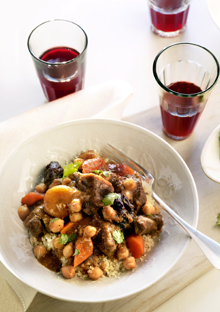The Creative Cook

Photo: Gentl & Hyers
PAGE 2
Another strategy is to repurpose ingredient combinations that are already familiar to you—asparagus with Fontina cheese and ham, for example. Instead of serving them the same way you always do (in a salad, perhaps), use those ingredients to make a sandwich or a pasta sauce (sauté the asparagus with diced ham, then grate the Fontina over the hot pasta at the last second).
Researching the book, says Page—a lifelong food scholar and Harvard MBA—meant excavating information that existed only "in the heads of chefs."
"Our goal was to collect it, synthesize it, and put it out there in a form that people can access," she says. Adds Dornenburg, coauthor (with Page) of six previous food books, including Culinary Artistry and What to Drink with What You Eat—and a former chef at Biba in Boston: "Almost every dish I've been cooking my whole life, I now have new ideas for."
To illustrate how flavor affinities can evolve into actual dishes, we started with several familiar, versatile ingredients (shrimp, potatoes, asparagus, lamb, pork) and created recipes around them, using suggested pairings from The Flavor Bible. Whether you prefer to follow these recipes or just use them to jump-start your own culinary forays, remember the first principle of creative cooking: Pay more attention to the flavors than to the instructions. And be ready to make adjustments—for instance, adding extra sugar if a fruit called for is not in season.
With practice, you'll learn to trust your senses as much as, if not more than, a recipe in a book. Before long, you'll find that the culinary authority you turn to most often for ideas and inspiration is...yourself.
Researching the book, says Page—a lifelong food scholar and Harvard MBA—meant excavating information that existed only "in the heads of chefs."
"Our goal was to collect it, synthesize it, and put it out there in a form that people can access," she says. Adds Dornenburg, coauthor (with Page) of six previous food books, including Culinary Artistry and What to Drink with What You Eat—and a former chef at Biba in Boston: "Almost every dish I've been cooking my whole life, I now have new ideas for."
To illustrate how flavor affinities can evolve into actual dishes, we started with several familiar, versatile ingredients (shrimp, potatoes, asparagus, lamb, pork) and created recipes around them, using suggested pairings from The Flavor Bible. Whether you prefer to follow these recipes or just use them to jump-start your own culinary forays, remember the first principle of creative cooking: Pay more attention to the flavors than to the instructions. And be ready to make adjustments—for instance, adding extra sugar if a fruit called for is not in season.
With practice, you'll learn to trust your senses as much as, if not more than, a recipe in a book. Before long, you'll find that the culinary authority you turn to most often for ideas and inspiration is...yourself.



